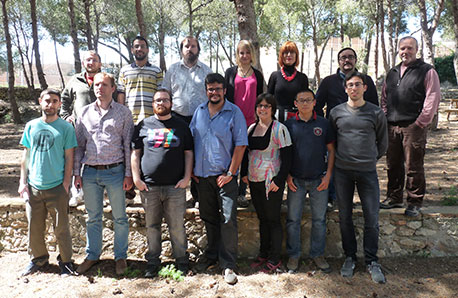López
Research group

Abstract
The aim of the group is to employ atomistic simulations to understand the mechanisms that govern chemical processes in heterogeneous catalysis and other materials that might be appealing due to their ability to extract, store or provide energy. Both the analysis of reaction networks, activity and selectivity issues and the final tests on the stability of the potential materials are fundamental to establish a solid background to determine the potentialities of catalyst candidates for a given chemical transformation. As for the new energy materials, their performance and stability are two of the main goals in our research. Our collaboration with several experimental groups is of fundamental importance to define and compare models that can later be applied to suggest experiments and new materials to be explored. To this end, the use of massive computational resources, as those provided by the RES-BSC is required. We are thankful to them for these resources that help in placing us as players at the European level.
Topics addressed
- Atomistic simulations of chemical processes in heterogeneous catalysis
- Understanding new energy materials’ performace and stability
Articles
“Theoretical Description of the Role of Halides, Silver, and Surfactants on the Structure of Gold Nanorods”
NANO Lett. (2014) 14, 871 – 875
N. Almora-Barrios, G. Novell-Leruth, P. Whiting, L. M. Liz-Marzán and N. López
“From the Lindlar Catalyst to Supported Ligand-Modified Palladium Nanoparticles: Selectivity Patterns and Accessibility Constraints in the Continuous-Flow Three-Phase Hydrogenation of Acetylenic Compounds”
Chem. Eur. J. (2014) 20, 5926 – 5937
G. Vilé, N. Almora-Barrios, S. Mitchell, N. López and J. Pérez-Ramírez
“Volcano-like Behavior of Au-Pd Core-shell Nanoparticles in the Selective Oxidation of Alcohols”
Sci. Rep. (2014) 4, 5766
T. A. G. Silva, E. Teixeira-Neto, N. López and L. M. Rossi
“A unified study for water adsorption on metals: meaningful models from structural motifis“
Phys. Chem. Chem. Phys. (2014) 16, 18933 – 18940
G. Revilla-López and N. López
“Solvent-Dependent Cation Exchange in Metal-Organic Frameworks”
Chem. Eur. J. (2014) 20, 6871-6874
C. K. Brozek, L. Bellarosa, T. Soejima, T. V. Clark, N. López and M. Dincă
“Costless Derivation of Dispersion Coefficients for Metal Surfaces”
J. Chem. Theory Comput. (2014) 10, 5002 – 5009
N. Almora-Barrios, G. Carchini, P. Błoński and N. López
“Collective Descriptors for the Adsorption of Sugar Alcohols on Pt and Pd(111)”
J. Phys. Chem. C (2014) 118, 17531 – 17537
R. García-Muelas and N. López
“Adsorption of small mono- and poly-alcohols on rutile TiO2: a density functional theory study”
Phys. Chem. Chem. Phys. (2014) 16, 14750 – 14760
G. Carchini and N López
“The Virtue of Defects: Stable Bromine Production by Catalytic Oxidation of Hydrogen Bromide on Titanium Oxide”
Angew. Chem. Int. Ed. (2014) 53, 8628 – 8633
M. Moser, I. Czekaj, N. López and J. Pérez-Ramírez
“Homolytic Products from Heterolytic Paths in H2 Dissociation on Metal Oxides: The Example of CeO2”
J. Phys. Chem. (2014) 118, 10921 – 10926
M. García-Melchor and N. López
“Unique Reaction Path in Heterogeneous Catalysis: The Concerted Semi-Hydrogenation of Propyne to Propene on CeO2”
ACS Catal. (2014) 4, 4015 – 4020
M. García-Melchor, L. Bellarosa and N. López
“A More Accurate Kinetic Monte Carlo Approach to a Monodimensional Surface Reaction: The Interaction of Oxygen with the RuO2(110) Surface”
ACS Catal. (2014) 4, 2328 – 2332
S. Pogodin and N. López
“Expanding and Reducing Complexity in Material Science Models with Relevance in Catalysis and Energy”
Top. Catal. (2014) 57, 14-24
K. Honkala, Z. ᴌodziana, I. N. Remediakis and N. López